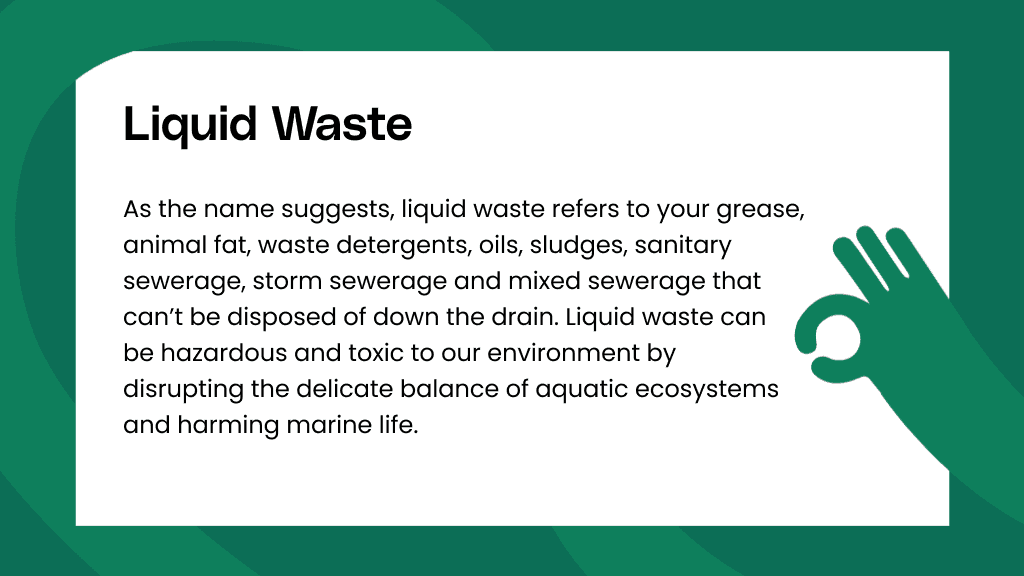The Of Reclaim Waste
The Of Reclaim Waste
Blog Article
The Ultimate Guide To Reclaim Waste
Table of ContentsNot known Factual Statements About Reclaim Waste The Ultimate Guide To Reclaim WasteThe Only Guide for Reclaim WasteThe Main Principles Of Reclaim Waste The Greatest Guide To Reclaim Waste
Explore the kinds, occurrences, and forms of liquid waste. Residential sewer waste describes the waste and products from a domestic septic storage tank. This kind of waste is developed by people in homes, colleges, and other buildings. This only includes septic systems that have a drain area. The correct monitoring and disposal of domestic sewage waste call for fluid waste to be transferred to a sewer treatment plant where the correct approaches and devices are put on detoxify and get rid of waste.
Commercial waste frequently consists of prospective dangers, such as combustible products or a blend of fluid and solid waste products, and requires an advanced and comprehensive disposal process. The disposal of industrial waste commonly involves the purification of waste prior to transportation to make certain risk-free and correct disposal. Industrial waste is produced from results and runoff of industrial procedures and manufacturing.
This kind of waste can not utilize the exact same sewage management transportation or procedures as septic or business liquids. The hazardous waste monitoring procedure calls for the evaluation and screening of fluid waste before it undergoes the disposal procedure (liquid waste removal melbourne). Overflow waste is the liquid waste that originates from runoff and excess stormwater in very booming areas or cities
Runoff waste can cause contamination and flooding if not managed properly. Discover a lot more concerning drain cleaning and waste management. Making certain appropriate waste management can avoid calamities and reduce ecological damage. Both individuals in household setups and professionals in business or manufacturing markets can take advantage of understanding the processes and regulations of fluid waste administration.
Get This Report about Reclaim Waste
Call PROS Services today to find out about our waste administration and disposal solutions and the proper methods to care for the liquid waste you produce.
(https://www.kickstarter.com/profile/reclaimwaste1/about)Do you recognize what happens to your water when you end, purge the toilet or drain pipes the cleaning device? No? Well, it deserves recognizing. This so-called 'wastewater' is not just a vital source yet, after treatment, will certainly be launched to our land, rivers or the ocean. Used water from commodes, showers, baths, cooking area sinks, washings and industrial procedures is called wastewater.

water used to cool equipment or clean plant and devices). Stormwater, a kind of wastewater, is overflow that moves from farming and city locations such as roofs, parks, yards, roadways, paths and rain gutters into stormwater drains, after rainfall. Stormwater flows unattended directly to local creeks or rivers, at some point reaching the ocean.
9 Simple Techniques For Reclaim Waste
In Queensland, a lot of wastewater is dealt with at sewer treatment plants. Wastewater is transferred from residential or industrial sites via a system of drains and pump stations, understood as sewerage reticulation, to a sewer treatment plant.
The Department of Natural Resources recommends regional federal governments about managing, operating and preserving sewerage systems and therapy plants. In unsewered areas, city governments might require householders to install individual or household sewage treatment systems to deal with domestic wastewater from commodes, kitchens, bathrooms and laundries. The Department of Natural Resources authorizes the use of household systems when they are proven to be efficient.
Most stormwater receives no treatment. In some brand-new communities, treatment of some stormwater to get rid of clutter, sand and gravel has actually begun using gross toxin traps. Wastewater treatment occurs in 4 phases: Gets rid of solid issue. Bigger solids, such as plastics and other items incorrectly released to sewers, are eliminated when wastewater is passed through screens.
Wastewater then moves into large containers where solids clear up and are removed as sludge. Grease and scum are skimmed from the surface area. Utilizes small living organisms referred to as micro-organisms to break down and get rid of continuing to be dissolved wastes and great particles. Micro-organisms and wastes are incorporated in the sludge. Removes nitrogen and phosphorus nutrients that might create algal flowers in our waterways and threaten aquatic life.
Things about Reclaim Waste
Nutrient elimination is not readily available at all sewage therapy plants due to the fact that it requires pricey specialized devices. It is becoming more common in Queensland. Clear fluid effluent created after treatment may still include disease-causing micro-organisms. If this effluent is launched into waterways such as rivers or the sea, the micro-organisms will ultimately die out.

Many wastewater moves right into the sewerage system. Under the Act, regional federal governments provide approvals and licences for eco appropriate activities (Ages) involving wastewater releases that might have a regional impact.
Top Guidelines Of Reclaim Waste
Monitoring offers factual info concerning water top quality and can validate that permit conditions are being satisfied. The info obtained via tracking gives the reference basis for making water top quality choices.
Report this page